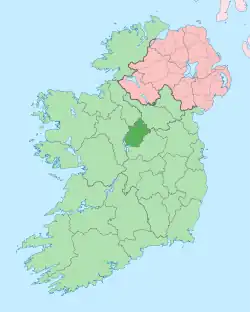Aughnacliffe
Aughnacliffe, officially Aghnacliff (Irish: Achadh na Cloiche, meaning 'field of the stones'),[2] is a village in County Longford, Ireland. It is located close to Lough Gowna and the border with County Cavan.
Aughnacliffe
Achadh na Cloiche | |
|---|---|
Village | |
 Aughnacliffe Location in Ireland | |
| Coordinates: 53°50′48″N 7°36′17″W | |
| Country | Ireland |
| Province | Leinster |
| County | County Longford |
| Population (2016)[1] | 177 |
The village, and the townland in which it is located, take their name from the Aughnacliffe Dolmen, a portal tomb which is located nearby.[3] There are a number of other megalithic sites in the area, and Sonnagh fort (a ringfort or rath) lies approximately 1.5 km (0.93 mi) south of the village.[3] The local Roman Catholic Church is dedicated to St. Columcille and was built in 1834.[4] St. Thomas's Church Of Ireland church, in the neighbouring townland of Rathmore, was built in 1829.[5][6] The local GAA club is Colmcille GFC.[7]
References
- "Sapmap Area - Settlements - Aughnacliffe". Census 2016. Central Statistics Office. April 2016. Archived from the original on 24 September 2021. Retrieved 31 January 2020.
- "Aughnacliffe / Achadh na Cloiche". logainm.ie. Irish Placenames Commission. Retrieved 31 January 2020.
- "Towns & Villages - Aughnacliffe". longford.ie. Longford County Council. Retrieved 31 January 2020.
The dolmen in Aughnacliffe gives the townland its name "The Field of the Stones"
- "St. Columkille's Roman Catholic Church, Aghnacliff, County Longford". buildingsofireland.ie. National Inventory of Architectural Heritage. Retrieved 31 January 2020.
- "St. Thomas Church Of Ireland, Rathmore (granard By.), County Longford". buildingsofireland.ie. National Inventory of Architectural Heritage. Retrieved 31 January 2020.
- "Co. Longford, Aughnacliffe, Church Of St Thomas (CI, Parish Of Columbkille". Dictionary of Irish Architects. Irish Architectural Archive. Retrieved 31 January 2020.
- "Rural broadband: Full list of high-speed internet hubs". The Irish Times.
This article is issued from Wikipedia. The text is licensed under Creative Commons - Attribution - Sharealike. Additional terms may apply for the media files.
